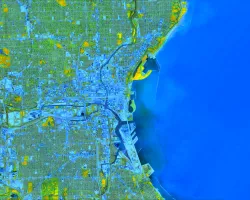
SERVIR, a joint initiative of USAID(link is external) and NASA(link is external), is working to protect tea crops – and the livelihoods of millions of Kenyans.
With Kenya third in the world in yearly tea production, the tea industry provides a living for about 4 million Kenyans, or about 10% of the total population.1 During winter months, these people sometimes face a subtle but pervasive enemy – frost.
Frost can cause millions of dollars in damage to tea crops. In January through March 2012, for example, a severe frost caused almost 30% tea crop loss in the Nandi area of Kenya.
Here's how frost does its dirty work.
When the temperature drops, the water inside a tea plant's cells changes from liquid to solid, expanding and forming ice crystals and rupturing the cell walls. Oxidation then turns the leaves brown. Tender young shoots, which have high moisture content, are the most prone to damage.
"Frost-affected tea bushes can take up to 3 months to recover, and some are lost completely,” explains Rhoda Ruto, a researcher at the Tea Research Foundation of Kenya (TRFK).
Unfortunately, the problem seems to be getting worse. According to a TRFK publication, "in recent times incidences are reported every year and indications are that the incidences are more severe and damaging." To protect their crops, farmers need to know when and where frost might occur.
“Farmers have been asking about early warnings,” notes Beatrice Cheserek, also of TRFK. "During a recent survey we conducted among farmers to gather information about damage due to hail, the overwhelming majority of farmers wanted to know if we were collecting information for frost as well."
If frost can be forecasted, measures can be taken to prevent crop losses. For example, some of the tea leaves can be picked right away.
SERVIR-Africa has just installed Wireless Sensor Networks (WSNs) in Kenya to support the automated frost mapping system they designed and implemented there several months ago. The near real-time frost mapping system identifies and displays frost-impacted areas by analyzing night time land surface temperature data from NASA's Moderate Resolution Imaging Spectroradiometer (MODIS) aboard the Terra and Aqua satellites. Each morning, within a few hours of data collection, the system emails user-friendly maps identifying areas with high potential for frost to the Kenya Meteorological Service (KMS), TRFK, and agricultural insurance companies.
In addition to the satellite data-derived frost products, the system will soon incorporate KMS WRF numerical prediction model forecasts to help map areas of potential frost up to 3 days in advance – giving farmers time to protect their crops. The newly-installed WSN in Kenya's Kericho Highlands will support these frost forecasting efforts, where tea farms are especially vulnerable to crop loss from winter frost. The sensors will provide field observations of temperature, wind speed, and humidity in sample locations within the tea fields at TRFK and correlate those observations with the forecasts and satellite data products. All of this will serve to more accurately define frost condition thresholds and to identify conditions when tea farmers should use frost damage mitigation strategies.
The WSN is a ground-based network of sensors that can be spread out over small geographic areas (3 or 4 square miles) to measure environmental conditions of interest. Operating almost entirely autonomously, the sensor networks are ideal for on-site monitoring. Intelligent power management at each network node reduces the need for external electricity and extends the life of onboard battery power systems, enabling the use of low-cost, low-power solar cells.
Absae Sedah, Kericho County Director of Meteorology, Kenya Meteorological Service, explains why TRFK was chosen as the location for the frost WSN: "Tea farmers in any part of the country depend on TRFK for research for improvement. That is why we thought it was good to start here and use their network to reach more farmers and companies."
RCMRD/SERVIR-Africa also installed a frost WSN onsite in Nairobi to help build the staff's knowledge and skills for deploying and running WSNs as the frost alert project and other SERVIR WSN projects expand.



